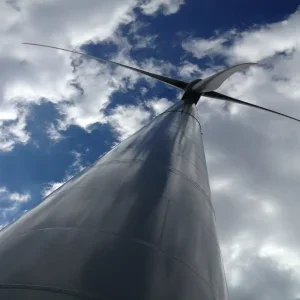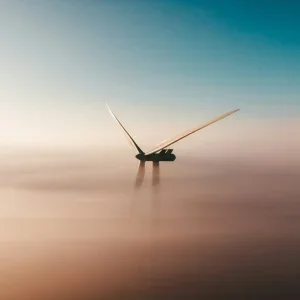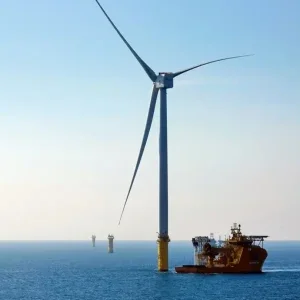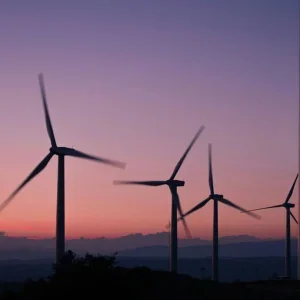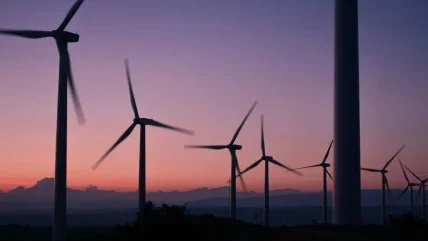
While inarguably pivotal to global efforts at combatting greenhouse gas emissions and climate change, offshore wind farms are undeniably harsh and hostile environments. And not just for the turbines themselves, but also for the workers who have to carry out maintenance and repair procedures to keep them in working condition.
Currently, there are almost 200 offshore wind farms operating globally, with China, the UK, Taiwan, Denmark and the Netherlands leading the field. The largest, Hornsea 2, is located 90km off the UK’s Yorkshire coast, consisting of 165 Siemens Gamesa 8MW wind turbines and an energy capacity of 1.32GW.
The UK’s upcoming Dogger Bank windfarm is set to eclipse Hornsea 2, however, when it is fully operational in 2025, with a total of 277 turbines producing an energy capacity of 3.6GW.
These massive windfarms are both quite recently developed, but others are far older. The lifespan of an offshore wind turbine is somewhere between 25–35 years, due in part to the atmospheric conditions they face, the pressure put on the materials and the wear and tear associated with its exposure to salt water. As a result, turbines require regular inspections and maintenance, requiring workers to travel out to sea and carry out potentially hazardous tasks under challenging conditions.
Indeed, there were 225 high-potential incidents reported within the UK’s offshore wind sector in 2022 alone, according to a report by G+, the Energy Institute’s health and safety organisation for the offshore wind sector. In total, more than 868 incidents and injuries were reported that year, with 325 taking place on a vessel, 298 on a turbine and 185 occurring onshore. With this in mind, stakeholders in offshore wind have begun to take notice of recent developments in robotics and automation, suggesting that a better solution might well be out there.
Reducing risk from the safety of land
For offshore wind turbines, all aspects of their life cycle – from construction through operation, maintenance and decommissioning – require workers to travel out to these remote sites for inspection or servicing. Transporting heavy and bulky objects; installing components; the volatile weather conditions and their impact on timeframe availability; operations conducted at dangerous heights; the flooding of components and areas; and changes to platform stability all present unique risks and challenges to workers.
Indeed, that’s before you even begin factoring in human error, as workers may have to deal with poor planning; being assigned the wrong tools; tiredness and fatigue; improper or delayed maintenance; and any number of other issues. Of course, these issues are frequently only identified when a worker is already on-site and will then require either the maintenance vessel returning to harbour or another vessel being sent out to the site – both solutions wasting considerable time in the process.
“When it comes to so-called ‘dull, dirty and dangerous tasks’, removing humans from these high-risk environments when possible will benefit not just their bottom line but also the health and safety of their personnel.”
While not a solution to all of these challenges, the offshore wind industry has seen significant developments in recent years in the field of robotics and automation, as companies look to reduce the demands and strain placed on their human workers. It’s long been clear to industry that, when it comes to so-called ‘dull, dirty and dangerous tasks’, removing humans from these high-risk environments when possible will benefit not just their bottom line but also the health and safety of their personnel.
In July 2021, the Offshore Renewable Energy (ORE) Catapult – the UK’s leading technology and innovation research centre for offshore renewable energy – released a paper looking into the myriad benefits that robotics could offer the sector. Titled ‘Quantifying the impact of robotics in offshore wind’, the report is one of several ‘Industry Insight’ studies, commissioned as part of the Offshore Wind Innovation Hub (OWIH). The authors analysed various cost-reduction opportunities that robotic applications could provide in the operations and maintenance (O&M) of offshore wind farms.
Among the many aspects of robotics examined in the paper, the authors noted that recent developments in offshore wind turbine inspection have seen the introduction of hybrid unmanned surface vessels (USVs) combined with electric remotely operated vehicles (eROVs). The use of these systems in offshore wind was a natural progression from the oil and gas industry, where they have been common practice for subsea operations since the 1980s – though, obviously, their electrification is a more recent addition.
Today, eROVs used in the offshore wind sector have seen a small level of automation integrated into their operations, but to date are typically tethered systems that are remotely controlled by personnel in support vessels on the surface. Whether automated or remotely controlled, of course, eROVS offer great potential to reduce risk and improve health and safety in this area, capable of performing maintenance and repair tasks on offshore wind turbines without a single human being physically present.
As the ORE Catapult paper notes, eROVs do not require hydraulic systems and are easier to deploy from surface vessels, allowing vessels to be unmanned. Since space for personnel is not required, they can be designed more efficiently so they are therefore smaller and considerably more fuel efficient, helping reduce carbon emissions.
Similarly, combined USV-eROV platforms offer further value as they can be controlled from onshore remote operation centres – essentially allowing for remote control of operations from the safety of land. This comes with its own challenges; remote long-range connectivity is yet to fully realise its potential, but developments in this area are already underway and will improve significantly in the short-to-medium term.
Put into practice
One such eROV platform is being developed by researchers from Heriot-Watt University and Imperial College London, working with the National Robotarium, the UK’s leading AI and robotics centre, in partnership with Fugro, a leading geodata specialist. The Underwater Intervention for Offshore Renewable Energies (UNITE) project has received £1.4m in funding, partly from the UK’s Engineering and Physical Science Research Council, and seeks to remove the need for crewed support vessels during maintenance procedures.
The UK has over 2,650 offshore wind turbines as of 2023, including those at Hornsea and Dogger Bank, with thousands more planned before 2050. Each turbine typically requires an average of up to three maintenance check-ups per year, which increases as turbines age and require higher levels of maintenance to stay fully operational.
Traditional maintenance methods for offshore wind turbines require vessels to transport teams of trained divers and ship-based crews on-site to manually inspect individual turbines – or, more recently, to deploy remotely operated robots to conduct the inspection and repair processes. This all translates into hundreds of thousands of man-hours committed to crewed maintenance missions each year, which is ultimately inefficient, costly and environmentally unfriendly, all while presenting a safety risk to workers.
The UNITE project is intended to support uncrewed and remotely operated vessels, developing autonomous and semi-autonomous eROVs capable of carrying out subsea inspection, maintenance and repair tasks – all while being deployed and controlled from an onshore site. Similarly, the project seeks to develop technologies to enable robots to create more accurate subsea terrain maps, while exploring how these robots autonomously interact with underwater structures during volatile conditions like changing currents or rough seas.
“We’re only a generation away from our obligation to deliver on our net zero promises by 2050 and 2045 in Scotland, so can’t afford to let the challenges faced by the offshore renewables sector slow down the construction and operation of essential, green energy assets like wind turbines,” said Professor Yvan Petillot, academic co-lead at the National Robotarium and principal investigator of the UNITE project, in a June 2023 press release.
“Remote inspection and repair using robotic systems deployed in the field and controlled from shore is within our grasp. The long-term ambition is for crewless boats to be able to do this autonomously without direct human control based on a predetermined maintenance cycle – critical if we’re to see the widespread adoption of robotics in the rapidly expanding offshore wind sector.”
First fully remote inspection of an offshore windfarm
In that same press release, Mark Bruce, global product manager at Fugro, made note of the potential that eROVs offer the offshore wind sector. “As the expansion and influence of marine robotics stretches ever further across the marine industry, we are committed to leading the industry’s remote and autonomous revolution,” he said. “Key to this is overcoming the challenges of remote operations by increasing our awareness and autonomy level in the sub-sea environment.”
Fugro, while part of the UNITE project, is developing a number of eROVs projects of its own. In April 2023, the company performed what it claimed as the first fully remote inspection of offshore windfarm facilities at the Aberdeen offshore wind farm in UK North Sea, also referred to as the European Offshore Wind Development Centre.
Supported by funding from Vattenfall and the ORE Catapult, the survey involved one of Fugro’s Blue Essence USVs and a Blue Volta eROV. Designed to be able to stay out at sea for up to two weeks without the need for refuelling, the Blue Essence line was the first USV to receive approval from the UK’s Maritime and Coastguard Agency (MCA) to operate fully remotely with an eROV during its inspection routine.
The Blue Volta eROV, meanwhile, was successfully launched and recovered remotely from Fugro’s operations centre in Aberdeen. Inspecting wind turbine structures to assess their safety and stability, the vessel also carried a deepwater multibeam echosounder sensor on its hull, while enabled Fugro to collect data to generate a detailed map of the surrounding seabed.
225
The number of high-potential incidents reported within the UK’s offshore wind sector in 2022.
G+
Beyond the work carried out by the National Robotorium and Fugro, similar eROV projects are also in works by groups like Oceaneering International and Saab Seaeye. Both offer robust and advanced ROV and eROV systems for offshore energy operations, focused on increased autonomy and enhanced data gathering and analysis while improving safety and reliability in demanding environments.
2,652
The number of offshore wind turbines in the UK across 43 windfarms by the start of 2023, with thousands more planned by 2050.
BBC
Ultimately, all industry players are united under one belief: that current conditions at offshore wind turbines pose an unnecessary risk to workers, and that eROV technology is poised to take these tasks over. If they improve maintenance downtime while also being more cost-effective, then that just sweetens the deal. However, with more and more offshore turbines set for construction over the coming decades, those latter points may well prove just as enticing.


